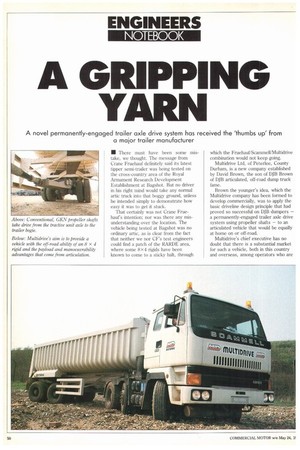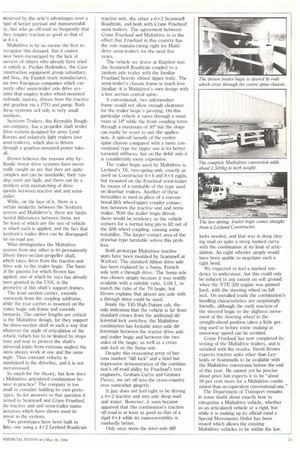A GRIPPING YARN
Page 58

Page 59

If you've noticed an error in this article please click here to report it so we can fix it.
A novel permanently-engaged trailer axle drive system has received the 'thumbs up' from a major trailer manufacturer
There must have been some mistake, we thought. The message from Crane Fruehauf definitely said its latest tipper semi-trailer was being tested on the cross-country area of the Royal Armament Research Development Establishment at Bagshot. But no driver in his right mind would take any normal artic truck into that boggy ground, unless he intended simply to demonstrate how easy it was to get it stuck.
That certainly was not Crane Fruehauf s intention; nor was there any misunderstanding over the location. The vehicle being tested at Bagshot was no ordinary artic, as is clear from the fact that neither we nor CF's test engineers could find a patch of the RARDE area, where some 8x4 rigids have been known to come to a sticky halt, through which the Fruehauf/Scammell/Multidrive combination would not keep going.
Multidrive Ltd, of Peterlee, County Durham, is a new company established by David Brown, the son of DJB Brown of DJB articulated, off-road dump truck fame.
Brown the younger's idea, which the Multidrive company has been formed to develop commercially, was to apply the basic driveline design principle that had proved so successful on DJB dumpers — a permanently-engaged trailer axle drive system using propeller shafts — to an articulated vehicle that would be equally at home on or off-road.
Multidrive's chief executive has no doubt that there is a substantial market for such a vehicle, both in this country and overseas, among operators who are ittracted by the artic's advantages over a igid of better payload and manoeuvrabilty, but who go off-road so frequently that :hey require traction as good as that of 8x4.
Multidrive is by no means the first to recognise this demand. But it cannot lave been encouraged by the lack of success of others who already have tried .o satisfy it. Poclain Hydraulics, the Case zonstruction equipment group subsidiary, ind Sisu, the Finnish truck manufacturer, ire two European companies which cur:ently offer semi-trailer axle drive sys• :ems that employ trailer wheel-mounted aydraulic motors, driven from the tractive mit gearbox via a PTO and pump. Both these systems sell only in very small numbers.
Scottorn Trailers, the Reynolds Boughton company, has a propeller shaft trailer irive system designed for army Land Rovers and relatively light trailers (not semi-trailers), which also is driven through a gearbox-mounted power takeff.
Brown believes the reasons why hyJraulic motor drive systems have never really caught on are that they are quite somplex and can be unreliable; their run:ling costs are high; and there can be a aroblem with mismatching of drive speeds between tractive unit and semitrailer.
While, on the face of it, there is a sertain similarity between the Scottom system and Multidrive's, there are fundamental differences between them, not the least of which are the size of vehicle to which each is applied, and the fact that icottorn's trailer drive can be disengaged for on-road use.
What distinguishes the Multidrive system from any other is its permanently iriven three-section propeller shaft, which takes drive from the tractive unit irive axle to the trailer bogie. The basis I the patents for which Brown has applied, one of which he says has already been granted in the USA, is the geometry of this shaft's support frames.
The front section carrier, extends rearwards from the coupling subframe, while the rear carrier is mounted on the trailer bogie sub frame and extends onwards. The carrier lengths are critical to the Multidrive design, for they support the three-section shaft in such a way that whatever the angle of articulation of the vehicle (which has to be limited by stops iont and rear to protect the shaft's miversal joints from extreme angles) the oints always work at one and the same Ingle. Thus constant velocity is maintained in the driveline, and it is not werstressed.
So much for the theory, but how does Multidrive articulated combination belave in practice? The company is too small to consider building its own proto:ypes. So for answers to that question it :urned to Scammell and Crane Fruehauf, he tractive unit and semi-trailer manukturers which have shown most in:erest in the system.
Two prototypes have been built to late, one using a 4x2 Leyland Roadtrain tractive unit, the other a 6x2 Scammell Roadtrain, and both with Crane Fruehauf semi-trailers. The agreement between Crane Fruehauf and Multidrive is to the effect that Fruehauf in this country has the sole manufacturing right for Multidrive semi-trailers for the next five years.
The vehicle we drove at Bagshot was the Scammell Roadtrain coupled to a tandem axle trailer with the familiar Fruehauf heavily ribbed tipper body. The semi-trailer's chassis frame is much less familiar: it is Multidrive's own design with a box section central spine.
A conventional, two sidemember frame would not allow enough clearance for the trailer bogie's pivoting. On this particular vehicle it turns through a maximum of 18° while the front coupling turns through a maximum of 30° but the stops can easily he reset to suit the application. A spin-off benefit of the centre spine chassis compared with a more conventional type for tipper use is its better torsional stiffness; but on the debit side it is considerably more expensive.
The trailer bogie used by Multidrive is Leytand's T6, two-spring unit, exactly as used on Constructor 6x4 and 8x4 rigids, but mounted on the Fruehauf semi-trailer by means of a turntable of the type used on drawbar trailers. Another of these turntables is used in place of a conventional fifth wheel/upper coupler connection between the tractive unit and semitrailer. With the trailer bogie driven there would be tendency as the vehicle corners for a normal king pin to lift out of the fifth wheel coupling, causing some instability. The larger contact area of the drawbar-type turntable solves this problem.
Both prototype Multidrive tractive units have been modified by Scammell at Watford. The standard Albion drive axle has been replaced by a Soma, French axle with a through drive. The Soma axle was chosen simply because it was readily available with a suitable ratio, 5.04:1, to match the ratio of the T6 bogie, but Brown explains that almost any axle with a through drive could be used.
Inside the T45 High Datum cab, the only indication that the vehicle is far from standard comes from the additional differential lock switches: the Multidrive combination has lockable inter-axle differentials between the tractor drive axle and trailer bogie and between the two axles of the bogie, as well as a cross axle lock on the Soma unit.
Despite this reassuring array of buttons marked "diff lock" and a brief but impressive demonstration of the combination's off-road ability by Fruehauf s test engineers, Graham Curtis and Graham Pierce, we set off into the cross-country area somewhat gingerly.
It just does not feel right to be driving a 6x2 tractive unit into axle deep mud and water. However, it soon became apparent that this combination's traction off-road is at least as good as that of a rigid 8x4 while its manoeuvrability is markedly better.
Only once were the inter-axle duff locks needed, and that was in deep cloying mud on quite a steep banked curve with the combination at its limit of articulation. An eight wheeler simply would have been unable to negotiate such a tight bend.
We expected to feel a marked tendency to understeer, but this could only be induced to any extent on soft ground when the NTE 320 engine was gunned hard, with the steering wheel on full lock. On metalled roads the combination's handling characteristics are surprisingly friendly, although the swift reaction of the steered bogie to the slightest movement of the steering wheel in the straight-ahead position takes a little getting used to before some snaking at motorway speed can be avoided.
Crane Fruehauf has now completed its testing of the Multidrive trailers, and is satisfied with the results. David Brown expects tractive units other than Leylands or Scammells to be available with the Multidrive conversion before the end of this year. He cannot yet be precise about price but expects it to be "about 20 per cent more for a Multidrive combination than an equivalent conventional one."
The Department of Transport remains in some doubt about exactly how to categorise a Multidrive vehicle, whether as an articulated vehicle or a rigid, but while it is making up its official mind a Special Movements Order has been issued which allows the existing Multidrive vehicles to be within the law.














































































